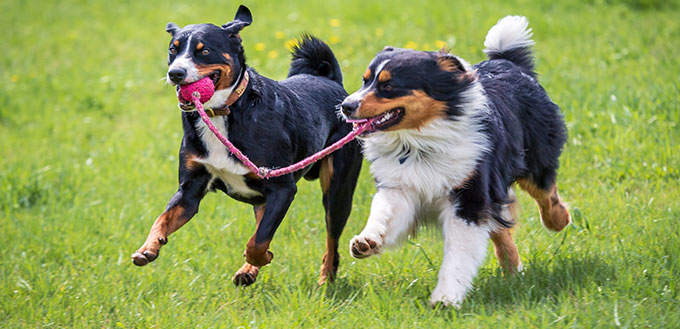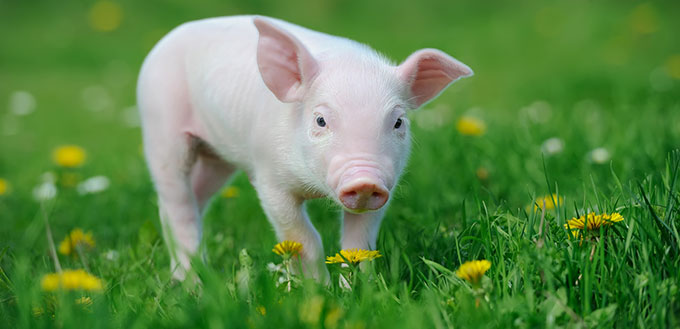Pigs are no longer considered to be a dumb farm animal. They have entered popular culture thanks to literary works such as Charlotte’s Web (portrayed as cute), Animal Farm (portrayed as wicked tyrants) and Babe (portrayed as brave heroes). Pigs now have personalities!
Apart from their obvious use as a source of animal protein in the human diet, they are also used by truffle harvesters. Their eyesight is not brilliant but they have a very keen nose that can hunt out this valuable fungus. They exist in some form in just about every part of the world but what do we really know about them? How intelligent are pigs and should we be considering them as a companion animal in the same way as we view dogs?
The answer to this very much depends on how you define intelligence in the context of animal suitability as human companions. You also have to remember that there is great variation in intelligence between breeds of dogs. Here we examine how smart pigs are and how that impacts their suitability as a pet for us compared to dogs.

Pigs as Pets
The main reasons for the debate about the intelligence of pigs are the ethics of using them as food animals and their suitability as pets. So, how does having a pig as a pet differ from having a dog?
There are certain breeds of pigs that are popular as micro, mini or teacup pigs. These are the Pot-Belly, Gloucester Old Spot, Kune Kune and Göttingen. Smaller individuals in the breeds have been selectively bred with each other to produce a small pig that people love to have as a pet! They really are very cute and stay that way throughout their life.
In terms of care, there are many similarities. Pigs need to have a balanced diet and need at least one walk a day. If they don’t get this, they put on weight and this leads to health issues. If they are lucky enough to enjoy good health, they will live for up to 25 years which is a little longer than the average dog. They are intelligent enough to be trained to poop and pee outside or in a designated area inside. They are naturally very clean animals and won’t like to poop or pee near their bedding or by their feeding area.
Pig Temperament
Pigs are very similar to dogs in that they are social animals and enjoy contact with humans a great deal. Therefore, you can encounter the pig equivalent of separation anxiety in dogs who are also pack animals and hate to be alone. They can even start to exhibit destructive behavior which is very similar to that seen in dogs and not a lot of fun for the humans who have to clear it up! For this reason, it may be unfair to keep a pig alone and it would be better if it could live with other animals. This could mean you need to get more than one pig or even a pig and a dog!
When it comes to training, pigs are definitely as intelligent as most dogs. They have personalities too! Most pigs are naturally curious and playful creatures but they are also headstrong. Their curiosity and intelligence make it possible to both housetrain and obedience train them. However, it also means that they need stimulation to stop them from getting bored. If you are a dog owner, you will be familiar with this!
They will behave very like dogs when it comes to the hierarchy of power within your household. If you do not show your new pup that you are the boss and not them, in the early stages of their training, they can start to show dominant and aggressive behavior towards human members of the family and other pets. Sadly, pigs will do the same and they need to have a member of the family who is a strong leader who will show them who is boss.
Pigs are more accustomed to being kept in groups than domestic dogs so their need to be with others could be even stronger. Pigs in a group will keep each other in check.
There are also similarities with many dog breeds when it comes to diet. In common with breeds like the Labrador, pigs can have a relentless need for food! This is where they demonstrate that their intelligence is equal to dogs. They will soon learn to open cupboards and tip over bins. They are very good at digging up gardens to get at tasty bulbs and roots as well. This behavior is called “rooting” and there is nothing that you can do about it. It is a natural instinct and it is important that they are allowed to indulge it.
Contrary to their undeserved reputation, they are not dirty creatures at all. They are generally very clean and are not any more unhygienic than dogs.

Pig Intelligence and Training
It soon becomes obvious that pigs are equally as intelligent to many dog breeds when it comes to training them. You use very similar methods to those used for a dog – they have functional long-term memories that work in the same way as the canine brain. By training your pig, you can get a well-mannered pet that is easy to control. Just like with dogs, it is best if you start at a young age and a well-trained pig is safer and happier.
Pigs, like most dogs, are highly motivated by food so your training will be structured around tasty treats which could include popcorn (not salted or buttered), cereals, apple pieces or halved grapes. Find a point in the day when your pig is most focused – this will not be just before a meal time because your pig will be too hungry or just before bed time because they will be too tired! You can teach a pig to walk politely in a harness as you can teach a pup to walk on a leash.
With repetition and consistency, you can teach a pig to go to bed when you say “bed”, to go outside for a poop when you say “potty” or to stand still so you can get a harness on them when you say “harness”.
Here are some commands that you can teach a pig.
- The ‘come’ command. Pigs have no problem learning to understand and obey this command. The best approach is to start by speaking the word every time you feed them so they learn to associate it with filling their bellies! Then move on to calling your pig from further away. Pigs respond well to both praise and healthy food treats. You can gradually cut down on treats and increase praise. Once this is mastered, harness and leash training will be much easier.
- The ‘sit’ command. This is a bit more challenging for a pig but is perfectly achievable if you persevere. You can get your pig to sit patiently and wait for their meals which is a lot less stressful than having them charging around the house when they are hungry! You must carry out this training on a carpet or rug so that your pig’s feet don’t slip out from under them. The best method is to show them the treat and lift it in front of their snout and up and over their head. This makes them raise their snout to follow the treat and their butt will touch the floor. When this happens say “sit” and give them the treat right away.
- The ‘no’ command. This could be one of the most useful commands your pig ever learns! Luckily, pigs are intelligent enough to learn this easily. Remember to balance it with positive reinforcement and praise for good behavior. A loud, firm “no” accompanied by a stop sign hand or finger pointing shows that you are displeased. Eventually, all you will have to do is simply raise your hand or finger. Physical punishment is never acceptable and will not work because your pig is unlikely to realize what they are being punished for.
- The ‘leave it’ or ‘out’ command. This can be used when your pig is in an area that they should not be in or are playing with something they should not touch. You need to learn how to read your pig’s body language. When you spot them heading somewhere that is off limits, you use the command and use your body to make the pig step back. Then you praise them and give them a treat. All you need to achieve to begin with is a few steps back. This will gradually increase and you should be able to control your pig from a distance. This command needs constant reinforcement for it to carry on being effective.
- The ‘wait or stay’ command. This is one of the more advanced commands but most pigs will get the hang of it eventually. The pig’s instincts will be telling them to run towards the treat so you must keep it hidden. Get your pig to sit first and then say “stay” using an appropriate hand gesture or finger point. When your pig has sat still for a moment, give them praise and the treat. Every time you do this, wait a little longer before giving the reward. Then work up to gradually taking steps back saying “stay”. Always return to your pig and give them a lot of praise and a treat.
- The ‘spin’ command. This trick involves your pig learning to turn in circles so it looks like they are dancing. It is surprisingly easy to teach them. All you have to do is make sure that they have noticed that you have a treat in your hand (this will not be hard) and then move it around their head in a large circle. Encourage your pig to use their feet and turn in a complete circle. As you are doing is say “spin” or you could even say “dance” which is very cute. Many pigs seem to really enjoy this!
- The ‘shake’ command. This is the porcine equivalent of giving a paw! You can teach your little pig to “give hoof”. You just gently touch the back of their hoof and say “shake” and give them a treat. When you have done this a few times, you can use more pressure on their hoof. However, never grab the hoof suddenly as this will alarm your pig. Some pigs are sensitive to being touched and need a while to get used to it. Others don’t mind at all! You will need to repeat this many times so they get the hang of it. Eventually, when you use the verbal command, they will lift their foot without being prompted to by a touch. When they do this, give them loads of enthusiastic praise. They will feel the positive energy and will want to please you again. You can carry out this command crouching down. If you don’t want to actually touch their foot, you can use a similar procedure to teach them to wave. There are several other variations so use your imagination!
The Final Word…
Ultimately, the research shows that in many ways, pigs are equally as intelligent as dogs and that some pigs are more intelligent than some dog breeds! This is very obvious in the way that you can train a pig in a comparable way to how you would train a dog. This simply would not work with other farm animals such as sheep or cattle.
However, dogs have hundreds of years of domestication on their side and have a lot of history as companion animals. Despite their intelligence, it is important to remember that pigs are not domesticated animals and that you must do your research before you take one on as a pet.






